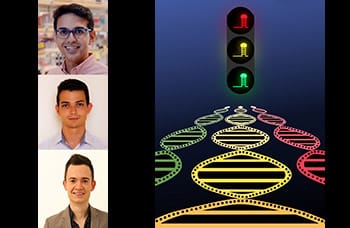In CRISPR genome editing, researchers leverage a variety of Cas9 enzymes, which race along strands of DNA and perform specific tasks, such as to knock out, activate, or inhibit certain genes. These targeted activities are deployed to pinpoint key genes involved in diverse diseases, advance our understanding of how cancer cells develop drug resistance, find potential new drug targets, and probe the underlying functions of the human genome.
But which Cas9 “racecar” is truly best for which task?
That question was a driving force behind a recent investigation conducted in the lab of Neville Sanjana, PhD, Core Faculty Member at the New York Genome Center, Assistant Professor of Biology, New York University, and Assistant Professor of Neuroscience and Physiology at NYU School of Medicine.
Using a massively-parallel forward genetic screen in human cells, the Sanjana Lab team, in a study co-led by postdoctoral scientists Mateusz Legut, PhD, and Zharko Daniloski, PhD, benchmarked a set of engineered Cas9 variants head-to-head. These variants were modified from the natural Cas9 to expand the space of genetic sequences that they can target. Their study, published today in Cell Reports, provides researchers with a performance evaluation scorecard of these widely used DNA targeting tools and a novel genetic screen to evaluate new genome editing tools. As part of their analysis, the team also ended up developing a new Cas9 enzyme that offers better performance in the particular task of gene activation.
“For the genome engineering community, there has been a proliferation in new CRISPR enzymes over the last few years and little guidance about which CRISPRs are best suited to specific tasks or how these CRISPRs compare to each other,” said Dr. Sanjana, senior author of the study. “Our study quantifies the performance of several Cas9 variants for three distinct yet common CRISPR functions – activation, inhibition, and knock-out – at thousands of sites in the human genome.”
Dr. Daniloski, who is the co-first author of the study, added that “a typical CRISPR pooled screen uses a library of guide RNAs. In this multi-CRISPR screen, we add another layer on top of that with several different CRISPR enzymes in the same pool.”
A key focus of the team’s analysis was assessing a major issue related to use of Cas9 enzymes: that they require a protospacer adjacent motif (PAM), a multi-base pair DNA sequence that must be present immediately following the intended DNA target site. This PAM requirement can constrain potential Cas9 applications, especially for genome regions where the PAM is not present or where precise positioning of Cas9 is essential, such as base editing or transcriptional modulation. The team’s study evaluated the performance of two PAM-flexible variants and the naturally-occurring Cas9 from the microbe S. pyogenes, which requires a longer PAM sequence. The researchers concluded that PAM flexibility indeed comes at a price of reduced performance, and that the PAM-flexible variant Cas9-NG outperformed the xCas9 variant in these cases. As the team explored these variables, they created and tested a new Cas9 variant, which they call “xCas9-NG.” This new variant proved to be superior to the other Cas9 variants studied in “turning on” genes, i.e., gene activation.
“We hope this work will be a valuable resource for researchers trying to decide which Cas9 variant to use for a specific genome engineering task,” said Dr. Legut, who is the co-first author of the study. “Despite the capabilities of these new variants, our study also highlights key unmet needs that remain to be addressed and that will require new genome editing tools.”
Along with Drs. Sanjana, Legut, and Daniloski, coauthors on the study include NYU graduate students Xinhe Xue, Dayna McKenzie, and Xinyi (Cathy) Guo and postdoctoral scientist Hans-Hermann Wessels, PhD.
Read the complete study here.
